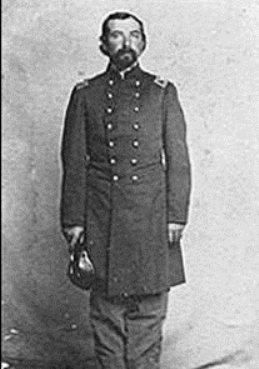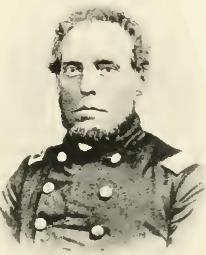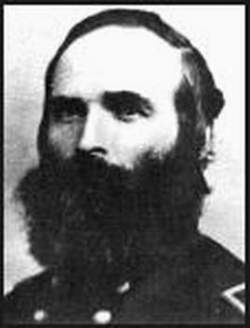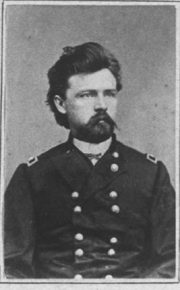
Nathan Kimball was a physician, politician, postmaster, and military officer, serving as a general in the Union army during the American Civil War. He was the first statewide commander of the Grand Army of the Republic veterans organization in Indiana.

Francis Marion Drake was an American merchant, lawyer, banker and politician. He fought in the American Civil War and later became the 16th Governor of Iowa. He is the namesake of Drake University.

The 8th Wisconsin Infantry Regiment was a volunteer infantry regiment that served in the Union Army during the American Civil War. The 8th Wisconsin's mascot was Old Abe, a bald eagle that accompanied the regiment into battle.

Egbert Benson Brown was a Union general in the Trans-Mississippi Theater of the American Civil War.

William Plummer Benton was an American lawyer and soldier who served in both the Mexican–American War and the American Civil War, where he would rise to the rank of brigadier general and, in 1866, after his service had ended, would be awarded the brevet grade of major general.

Frederick Knefler served in the Union Army in the U.S. Civil War, joining as a first lieutenant in May 1861. He served as a staff officer and as colonel of the 79th Indiana Infantry Regiment and an acting brigade commander. In 1866, he was nominated and confirmed for appointment to the grade of brevet brigadier general of volunteers, to rank from March 13, 1865. His daughter married Edward Taussig and he was the grandfather of Joseph Taussig, the great-grandfather of Joseph K. Taussig Jr. and great-great-grandfather of Captain Joseph K. Taussig III USMC.

Sylvester Gardner Hill (1820-1864) was a colonel in the Union Army during the American Civil War. He served as a brigade commander during the Red River Campaign and Battle of Nashville where he was killed in action. He received a posthumous appointment as a brevet brigadier general.
The 154th Regiment, Tennessee Infantry was an infantry regiment from Tennessee that served with the Confederate States Army in the American Civil War. Raised originally in 1842 as the 154th Tennessee Militia it sought to retain its number and was as such also known as 154th (Senior) Tennessee Infantry . Consolidating with the 13th Tennessee Infantry Regiment in March 1863 it was known as 13th-154th Tennessee Infantry Regiment; and had a number of temporary field consolidations until it was finally merged into the 2nd Consolidated Tennessee Infantry on April 9, 1865. The regiment surrendered with the remnants of the Army of Tennessee at Bennett Place on April 26, 1865.

The 9th Arkansas Infantry Regiment was a regiment of the Confederate States Army during the American Civil War. It served in the Western Theater, seeing action in the Vicksburg, Tennessee and Georgia campaigns. Due to attrition; the 9th Arkansas was consolidated several times with other Arkansas regiments, finally merging in 1865 into the 1st Arkansas Consolidated Mounted Rifles.
The 46th Arkansas Infantry (Mounted) (1864–1865) was a Confederate Army Mounted Infantry regiment during the American Civil War. While authorized by the State Military Board as an infantry regiment, the unit was mounted for Price's Missouri Expedition and served as mounted infantry. Due to its mounted status, the unit is sometimes referred to as the 46th Arkansas Cavalry when a numerical designation is used. The unit is almost always referred to as either Coleman's Arkansas Cavalry Regiment or Crabtree's Cavalry in official reports from the period.
The 47th Arkansas Infantry (Mounted) (1864–1865) was a Confederate Army Mounted Infantry regiment during the American Civil War. While authorized by the State Military Board as an infantry regiment, the unit was mounted for Price's Missouri Expedition and was officially designated as mounted infantry. Due to its mounted status, the unit is sometimes referred to as the 47th Arkansas Cavalry when a numerical designation is used. The unit is most often referred to as Crandell's Arkansas Cavalry Regiment, after its commander Colonel Lee Crandell.
Benjamin Franklin Gordon, commonly known as B. Frank Gordon, was a Confederate States Army colonel during the American Civil War. Gordon had been a private and bugler for a Missouri regiment serving in the U.S. Army during the Mexican–American War. Gordon served in the Confederate Army under Brigadier General Joseph O. "Jo" Shelby in Missouri and Arkansas in the Confederate Trans-Mississippi Department throughout the war. On May 16, 1865, with the war coming to an end, General E. Kirby Smith, as the Confederate commander of the Trans-Mississippi Department, assigned Gordon to duty as a brigadier general. The Confederate government took no action on the appointment and Confederate President Jefferson Davis did not officially appoint and nominate Gordon to the rank of brigadier general because the Confederate Senate last met on March 18, 1865, and Davis was captured by Union troops on May 10, 1865. Although he was only aged 40 at his death, Gordon survived the war by little more than a year.
89th Indiana Infantry Regiment was an infantry regiment that served in the Union Army in the Western Theater of the American Civil War.

Gustavus Adolphus Smith was a prosperous carriage maker in Decatur, Illinois before the American Civil War. He was a volunteer Union Army colonel from the beginning of the war until September 22, 1863 and from February 28, 1865 until December 14, 1865. After the end of the war, on January 13, 1866, President Andrew Johnson nominated Smith for appointment to the grade of Brevet brigadier general of volunteers, to rank from March 13, 1865. The United States Senate confirmed the appointment on March 12, 1866. Starting in 1870, Smith was a collector of internal revenue in New Mexico.
The 4th Missouri Infantry Regiment was formed on April 28, 1862, and served in the Confederate States Army during the American Civil War. The infantry regiment did not see action at the Battle of Farmington on May 9, and the Battle of Iuka on September 19 despite being part of the Confederate force present at those battles. As part of Brigadier General Martin E. Green's brigade, the regiment participated in three charges against Union lines on October 3, 1862, during the Second Battle of Corinth. The following day, the regiment, along with the rest of Green's brigade, attacked the new Union lines. Despite initial success, the attack was repulsed by a Union counterattack. The regiment ceased to exist as a separate unit when it was combined with the 1st Missouri Infantry Regiment on November 7, 1862, to form the 1st and 4th Missouri Infantry Regiment (Consolidated).
Nichols's Missouri Cavalry Regiment served in the Confederate States Army during the late stages of the American Civil War. The cavalry regiment began recruiting in early 1864 under Colonel Sidney D. Jackman, who had previously raised a unit that later became the 16th Missouri Infantry Regiment. The regiment officially formed on June 22 and operated against the Memphis and Little Rock Railroad through August. After joining Major General Sterling Price's command, the unit participated in Price's Raid, an attempt to create a popular uprising against Union control of Missouri and draw Union troops away from more important theaters of the war. During the raid, while under the command of Lieutenant Colonel Charles H. Nichols, the regiment was part of an unsuccessful pursuit of Union troops who were retreating after the Battle of Fort Davidson in late September.

Theodore Harvey Barrett (1834-1900) was an American Brevet Brigadier General who commanded the 1st Missouri Colored Infantry Regiment in the later years of the American Civil War and was known as the commander of the Battle of Palmito Ranch which was the final battle of the war.

James Clarence Rogers (1838-1907) was an American Brevet Brigadier General who commanded the 123rd New York Infantry Regiment in the American Civil War. He was known for being the commander of the 123rd New York during the Battle of Gettysburg. He would later become a lawyer and a member of the New York State Assembly, representing Washington County.

Louis Douglas Watkins was a soldier in the Union Army during the American Civil War.

Robert Charles Bradshaw (1840–1927) was an American Brevet Brigadier General during the American Civil War. He commanded the 44th Missouri Infantry Regiment throughout various battles of the Franklin–Nashville campaign.












